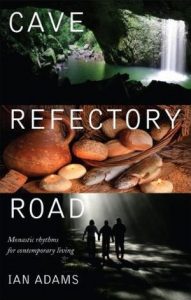Cave Refectory Road
 “Where do you go when the tidal wave of stuff coming your way threatens to break on you and consume you?” I suppose that is every parent’s question at some point. But most parents probably would not turn to monastic wisdom for insights about managing life in such moments.
“Where do you go when the tidal wave of stuff coming your way threatens to break on you and consume you?” I suppose that is every parent’s question at some point. But most parents probably would not turn to monastic wisdom for insights about managing life in such moments.
Ian Adams’ “Cave Refectory Road,” however, urges people of all kinds to do precisely that. He is one of those endeavoring to counteract the misunderstanding that monastic ways of life are unrelated to the lives most of us lead.
The curious title of Adams’ book points toward two essentials of monastic life that at first appear opposed, but actually are complementary. On the one hand, the term “cave” refers to the “stillness, study and prayer” that shape every monastic movement. He has “found it really helptul to create a simple prayer space — a kind of monastic cave” at home. On the other hand, “refectory”–a communal dining room–signifies the way of life for an individual or a community attempting to follow the ways of the “hospitable Jesus.” Adams explains that a “flow between prayerful engagement with God and activity on behalf of the world” is typical of monastic life.
“I sense that there’s a deep stream of possibility in the monastic way that can help us in the 21st century to find new ways to live – in balance with ourselves, reconnected to our fellow humanity, in harmony with the planet and at ease with Mystery,” Adams writes.
The balanced life that this Anglican priest discovers in monasticism, with its established rhythm of life, sounds like every married person’s and every parent’s greatest hope. For one thing, the author believes the rhythm of life observed in monasticism suggests to the rest of us that “most of our hurrying is unnecessary and perhaps even harmful.”
It is Adams’ conviction and hope that the traditional monastic way of life will “help to bring about something truly hopeful for the world – a new flowering of personal and community life in the 21st century.” Substitute “family” for “community” in that sentence and it becomes clear why this book can be applied to the life of lay people in numerous ways.
The author proposes 10 “particular ways in which the ancient religious life … may shape a renewed way of being truly human in and for the world.”
Simplicity in life is an important monastic value, as is the sense of community experienced at the table where we gather to eat and the willingness to serve as reconcilers in the world around us. Thus, Adams writes:
— “The table becomes the place of hospitality, engagement and encounter. … The meal should not be rushed or seen as a means to another end. The sharing of food and the hearing of each other’s stories is the making of community.”
— “We can’t help others into peace and reconciliation if we are not yet peaceful or reconciled ourselves, but insofar as we take steps in this direction then the possibilities of peace and reconciliation may ripple out.”
— “How can we live more simply where we are? My suggestion here is to make an act of simplification each week. And a good place to start, in the way of the monastics, might be with our clothing. … Take a step toward a simpler wardrobe.”
So, while this is not a book specifically about married or family life, it is one whose insights couples and families can apply. A chapter titled “The Way of Devotion – Learning From the Vow of Chastity” is likely to prove thought-provoking for many couples.
In this chapter, Adams suggests “the creation of a simple pattern of devotion” between people who love each other. He suggests “that at its best the monastic vow of chastity or celibacy is a call to devotion, and the religious life is a passionate call to love – to fall into the love of God, to throw oneself into the love of neighbor and to be immersed in the love of life.”
One bit of advice in this chapter may be beneficial not only for couples, but for entire families. Adams writes:
“Make a decision together to devote … time to being together in the coming week, where you will give each other attention. This could involve conversation, but I suggest that some silence together may prove to be particularly helpful. Do what feels comfortable, perhaps take a walk or get a drink together. Resolve to try truly to hear and see each other.”
The monastic life not only values simplicity in life, but urges its members to stay close to creation and care for it, and give care to others in need. At a time when a new pope who takes his name from St. Francis of Assisi is reaffirming precisely such values, this book seems especially timely.
The friar Francis famously understood the connectedness of all things and celebrated God’s great creation,” Adams notes. “To care for the earth wherever we are,” he says, “is to step into the monastic stream.”
Disclaimer: Book reviews do not imply and are not to be used as official endorsement by the USCCB of the work or those associated with the work. Book reviews are solely intended as a resource regarding publications that might be of interest to For Your Marriage visitors.




